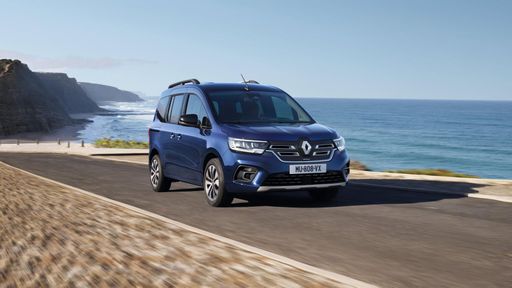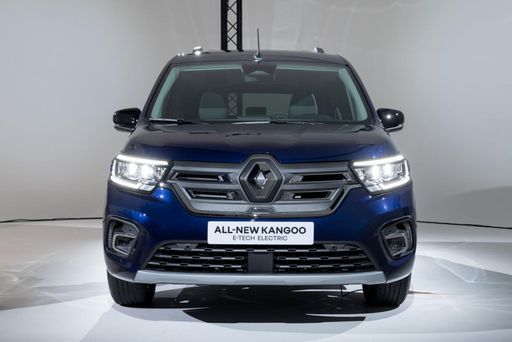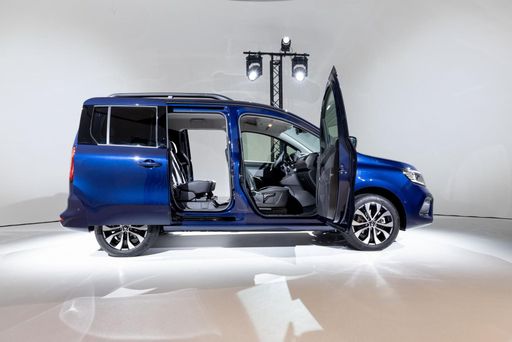Mercedes Citan vs Renault Kangoo Compact Van - Differences and prices compared
Costs and Efficiency:
Looking at overall running costs, both models reveal some interesting differences in everyday economy.
Renault Kangoo Compact Van has a barely noticeable advantage in terms of price – it starts at 22400 £, while the Mercedes Citan costs 22400 £. That’s a price difference of around 3 £.
Fuel consumption also shows a difference: Renault Kangoo Compact Van manages with 5.10 L and is therefore hardly perceptible more efficient than the Mercedes Citan with 5.20 L. The difference is about 0.10 L per 100 km.
In terms of energy consumption, the advantage goes to the Renault Kangoo Compact Van: with 18.70 kWh per 100 km, it’s barely noticeable more efficient than the Mercedes Citan with 19.30 kWh. That’s a difference of about 0.60 kWh.
As for range, the Renault Kangoo Compact Van performs barely noticeable better – achieving up to 290 km, about 10 km more than the Mercedes Citan.
Engine and Performance:
Under the bonnet, it becomes clear which model is tuned for sportiness and which one takes the lead when you hit the accelerator.
When it comes to engine power, the Mercedes Citan has a barely noticeable edge – offering 131 HP compared to 122 HP. That’s roughly 9 HP more horsepower.
In acceleration from 0 to 100 km/h, the Renault Kangoo Compact Van is a bit quicker – completing the sprint in 11.60 s, while the Mercedes Citan takes 13 s. That’s about 1.40 s faster.
In terms of top speed, the Mercedes Citan performs barely noticeable better – reaching 183 km/h, while the Renault Kangoo Compact Van tops out at 176 km/h. The difference is around 7 km/h.
There’s also a difference in torque: pulls stronger with compared to . That’s about difference.
Space and Everyday Use:
Beyond pure performance, interior space and usability matter most in daily life. This is where you see which car is more practical and versatile.
Seats: offers more seating capacity – vs .
In curb weight, Renault Kangoo Compact Van is barely noticeable lighter – 1493 kg compared to 1556 kg. The difference is around 63 kg.
In maximum load capacity, the Renault Kangoo Compact Van performs evident better – up to 4900 L, which is about 1240 L more than the Mercedes Citan.
When it comes to payload, Renault Kangoo Compact Van evident takes the win – 901 kg compared to 644 kg. That’s a difference of about 257 kg.
Who comes out on top?
Overall, the Renault Kangoo Compact Van shows itself to be dominates this comparison and secures the title of DriveDuel Champion.
It convinces with the more balanced overall package and proves to be the more versatile choice for everyday use.
 @ Renault Group Media
@ Renault Group Media
Renault Kangoo Compact Van
Costs and Consumption
View detailed analysis
Engine and Performance
View detailed analysis
Dimensions and Body
View detailed analysis
Mercedes Citan
The Mercedes Citan is a clever urban van that dresses sensible practicality in a surprisingly premium suit, making light work of deliveries and family duties without feeling like a workhorse. With a calm, car-like driving feel, clever interior packaging and the Mercedes badge up front, it’s a smart pick for buyers who want function with a touch of luxury and a wink of personality.
detailsRenault Kangoo Compact Van
The Renault Kangoo is a practical, no-nonsense compact van that turns urban deliveries and weekend DIY runs into a surprisingly easy chore. Roomy for its size, comfortable to drive and brimming with smart storage solutions, it’s a sensible pick for anyone who needs honest utility without drama.
details @ Renault Group Media
@ Renault Group Media
 @ Renault Group Media
@ Renault Group Media
 @ Renault Group Media
@ Renault Group Media
 @ Renault Group Media
@ Renault Group Media
 @ Renault Group Media
@ Renault Group Media
 @ Renault Group Media
@ Renault Group Media
 @ Renault Group Media
@ Renault Group Media
|
|
|
|
|
Costs and Consumption |
|
|---|---|
|
Price
22400 - 30100 £
|
Price
22400 - 37000 £
|
|
Consumption L/100km
5.2 - 7.4 L
|
Consumption L/100km
5.1 - 5.5 L
|
|
Consumption kWh/100km
19.3 - 20.7 kWh
|
Consumption kWh/100km
18.7 - 21.1 kWh
|
|
Electric Range
265 - 280 km
|
Electric Range
261 - 290 km
|
|
Battery Capacity
45 kWh
|
Battery Capacity
-
|
|
co2
0 - 167 g/km
|
co2
0 - 151 g/km
|
|
Fuel tank capacity
54 L
|
Fuel tank capacity
54 L
|
Dimensions and Body |
|
|---|---|
|
Body Type
High Roof Estate
|
Body Type
Cargo Van
|
|
Seats
5
|
Seats
2 - 5
|
|
Doors
5
|
Doors
4 - 5
|
|
Curb weight
1556 - 2010 kg
|
Curb weight
1493 - 1910 kg
|
|
Trunk capacity
0 - 551 L
|
Trunk capacity
-
|
|
Length
4498 - 4922 mm
|
Length
4486 - 4910 mm
|
|
Width
1859 mm
|
Width
1860 mm
|
|
Height
1811 - 1830 mm
|
Height
1854 - 1864 mm
|
|
Max trunk capacity
1979 - 3660 L
|
Max trunk capacity
3000 - 4900 L
|
|
Payload
485 - 644 kg
|
Payload
498 - 901 kg
|
Engine and Performance |
|
|---|---|
|
Engine Type
Petrol, Diesel, Electric
|
Engine Type
Diesel, Electric
|
|
Transmission
Manuel, Automatic
|
Transmission
Manuel, Automatic
|
|
Transmission Detail
Manual Gearbox, Dual-Clutch Automatic, Reduction Gearbox
|
Transmission Detail
Manual Gearbox, Dual-Clutch Automatic, Reduction Gearbox
|
|
Drive Type
Front-Wheel Drive
|
Drive Type
Front-Wheel Drive
|
|
Power HP
95 - 131 HP
|
Power HP
75 - 122 HP
|
|
Acceleration 0-100km/h
13 - 15.5 s
|
Acceleration 0-100km/h
11.6 - 18.9 s
|
|
Max Speed
132 - 183 km/h
|
Max Speed
132 - 176 km/h
|
|
Torque
200 - 270 Nm
|
Torque
230 - 270 Nm
|
|
Number of Cylinders
4
|
Number of Cylinders
4
|
|
Power kW
70 - 96 kW
|
Power kW
55 - 90 kW
|
|
Engine capacity
1332 - 1461 cm3
|
Engine capacity
1461 cm3
|
General |
|
|---|---|
|
Model Year
2021 - 2024
|
Model Year
2022 - 2024
|
|
CO2 Efficiency Class
F, E, A
|
CO2 Efficiency Class
D, E, A
|
|
Brand
Mercedes-Benz
|
Brand
Renault
|
What drive types are available for the Mercedes Citan?
Available configurations include Front-Wheel Drive.
The prices and data displayed are estimates based on German list prices and may vary by country. This information is not legally binding.
